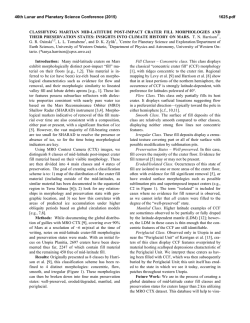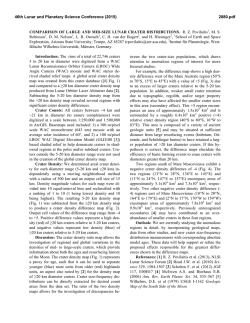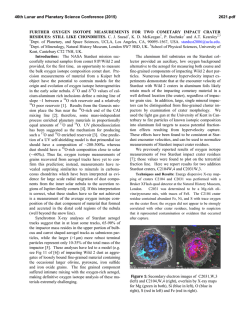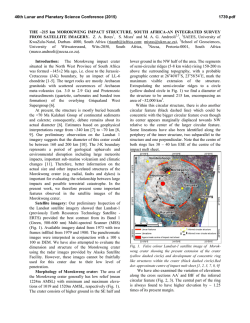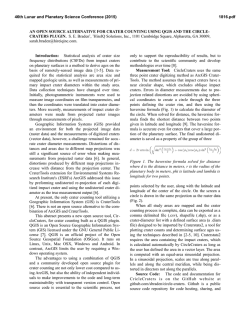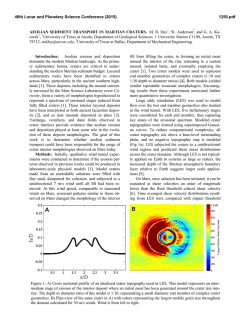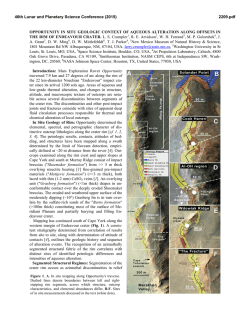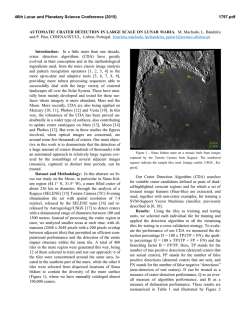
Morphometry of Recent Simple Impact Craters on Mars
46th Lunar and Planetary Science Conference (2015) 2465.pdf MORPHOMETRY OF RECENT SIMPLE CRATERS ON MARS: SIZE AND TERRAIN DEPENDENCE W. A. Watters ([email protected]), L. Geiger, M. Fendrock, R. Gibson; Department of Astronomy, Wellesley College We examine the morphometry of N = 384 relatively well-preserved simple impact craters on Mars using high-resolution stereo topography (≥ 1 m/px) [1]. In particular, we characterize the dependence of morphometric parameters on crater diameter (25 m < D < 5 km) as well as geologic setting and modification state. This work also provides a comparison of two popular methods used to generate topography from high-resolution stereo images [1]. Motivation. The majority of studies of simple crater morphometry on Mars from the past decade have used elevation models derived from laser altimetry [e.g., 2, 3, 4]. More recent studies have made use of roverbased observations and high-resolution orbiter imagery [e.g., 5, 6]. With the advent of stereo imagery from the High-Resolution Imaging Science Experiment (HiRISE) on the Mars Reconnaissance Orbiter (MRO) [7], it has become possible to generate elevation models with a resolution of 1 m/px [8, 9]. With these new products, we can examine transitions in crater shape with unprecedented detail in a global crater population, as well as the size-dependent scaling of fine-scale features such as rim shape. Our goals in this work are to (a) refine constraints for crater formation models by characterizing the size dependence of crater and rim shape; (b) characterize the “initial condition” of crater shapes in different settings on Mars for the purpose of (c) understanding how short- and long-term surface processes modify crater shape and drive the evolution of the martian surface. Methods. We used the open source Ames Stereo Pipeline 2.0 to generate our elevation models [9]. We have characterized the difference between these products and HiRISE Team-published products generated using the proprietary SOCET SET tool [8], finding an average pixel-to-pixel elevation discrepancy of < 0.5 m (after rotation and translation of the crater model to match the orientation as well as the centroid of the rim planform). We use in-house Python scripts to extract the crater rim and radial elevation profiles, and to measure morphometric parameters in a mostly automatic fashion [10]. We compute all of the following morphometric quantities: (a) cavity volume; (b) rim diameter; (c) rimto-floor depth; (d) curvature radius of rim walls; (e) vertical angular span of the crater rim; (f) crater rim and flank slopes; (g) rim height; and (h) exponent of power-law fit to crater cavity cross-section. We also characterize crater modification state and record the terrain type using a global geologic map (e.g., lava flows and plains, coarse sediments, fine sediments, impact units) [11]. We examine in detail the dependence of all morphometric quantities (a-h) upon crater diameter as well as geologic setting and modification state. The latter is assessed by characterizing the preservation of ejecta and presence of crater cavity fill. Our approach is to measure the distribution of values for each morphometric parameter from craters in different categories of modification state and target materials, and draw comparisons using the Kolmogorov-Smirnov test to determine whether any two distributions exhibit a statistically-significant difference. Results. The average curvature radius of the upper rim wall follows a well-defined scaling law up to D ≈ 1 km (see Fig. 1). For larger sizes, this quantity increases abruptly (crater rims sharpen significantly; see Fig. 1). We also find that rim and flank slopes increase with crater diameter until D ≈ 1 km, where super-critical slopes are reached (see Fig. 2). That is, repose-angle slopes on the uppermost rim wall occur at diameters comparable to the aforesaid rim shape transition diameter. We therefore suggest that additional gravitydriven wasting of the rim walls occurs for D ≥ 1 km, which in turn presages the more dramatic simple-complex transition at somewhat larger diameters. We find that scaling laws formerly derived from simple craters in Mars Orbiter Laser Altimeter (MOLA) along-track profiles and elevation models [2, 3, 4], when extrapolated to the small crater size regime, tend to significantly overestimate small crater depth and volume. Scaling laws for this small crater regime (D < 1 km) agree most closely with the early estimates of R. J. Pike [12] based on photoclinometric and shadow-length measurements, who found that d ~ 0.2Dm where m ≈ 1 for rim-to-floor depth d. In agreement with prior studies, we find that the ra tio of rim-to-floor depth over diameter (d/D) is larger, on average, in stronger materials such as lava plains units. We also find that many craters in the ice-rich northern plains exhibit features of craters forming in high-strength materials, suggesting strong materials at shallow depths in these regions. Craters exhibiting ejecta with lobate margins have the steepest flank slopes, consistent with the suggestion that these craters are affected by landsliding of flank materials [13]. Rim height and floor depth are strongly and positively correlated for highly pristine craters, and this correlation weakens sharply as modification increases. Rim heights show a relatively weak dependence on 46th Lunar and Planetary Science Conference (2015) modification state when compared with crater depth, suggesting that burial rather than erosion is the more efficient modification process affecting overall crater shape. At low latitudes (in the absence of shallow subsurface ice), crater rim walls tend to flatten rather than become more rounded as they are modified in the short term, which suggests that back-wasting of crater walls dominates at early times, rather than a diffusive process such as soil creep (which may dominate the long-term modification and lead to rounding of crater rims). The initial shape of crater cavities is intermediate between conical and paraboloidal, with an average power-law exponent of ≈1.75. Small craters tend to be more conical (typical of Odessa-style low-velocity impacts). This is unlikely to be the result of strong drag on small objects in the thin martian atmosphere, but may result from contamination of our data set at small sizes by remote secondary craters. (Obvious secondary craters in prominent rays have been excluded). Paraboloidal craters also tend to form more commonly in high-strength targets. Finally, craters tend to become more paraboloidal or super-paraboloidal with increasing modification. 2465.pdf Fig. 2: Uppermost crater wall slope (φc2) versus log of crater diameter in meters. On average, rim wall slope increases with diameter but does not attain super-critical slopes (above typical repose angles) in significant numbers except for D > 1 km, coincident with the rim shape transition shown in Fig. 1. The meaning of the modification states “highly”, “moderately”, and “least” are defined in [1]. Future work. This work has established the baseline variation of morphometric properties of relatively recent simple impact craters on Mars for comparison with other populations. Ongoing work has characterized the morphometry of recent secondary impact craters and the size-dependent scaling of crater rim planforms. Going forward, our goal is to characterize the long-term modification sequence of small craters in a wide range of surface environments. Our understanding of the observed transition in rim shape will benefit from a similar analysis of small lunar craters. Fig. 1: Log-log plot of curvature radius of upper rim wall (ξc) versus crater diameter (in meters). “R&C” refers to the “ridge-and-chute” morphology commonly observed on upper crater walls and associated with landsliding. Square markers (< 0.5C) indicate that these features were observed around less than 50% of the crater rim circumference, and circles (> 0.5C) indicate that they were observed around more than 50% of the crater rim circumference. The diameter dependence is well-described by a power law for D < 1 km, above which crater rims tend to be sharper (upper rim wall is flatter) in an azimuthally-averaged sense. References: [1] Watters, W.A. et al., J. Geophys. Res. Planets, 2015 (accepted). [2] Garvin, J. et al., Icarus, 144, 2000; [3] Stewart, S. & G. Valiant, Meteor. & Planet. Sci. 41, 2006; [4] Robbins, S and B. Hynek, J. Geophys. Res. Planets, 117, 2012; [5] Daubar, I. J., et al. J. Geophys. Res. Planets, 119, 2014. [6] Golombek, M. et al., J. Geophys. Res. Planets, 119, 2014; [7] McEwen, A. et al., J. Geophys. Res. Planets, 112, 2007; [8] Kirk et al., J. Geophys. Res. Planets 113, 2007; [9] Moratto, Z., et al., LPSC 41, #2364, 2010; [10] Geiger, L., Wellesley College Honors thesis, 2013; [11] Tanaka et al., USGS sci. investigation map #3292, 2014; [12] Pike, R.J., LPSC 11, 1980; [13] Barnouin-Jha, O.S. et al., J. Geophys. Res. Planets, 110, 2015.
© Copyright 2026

